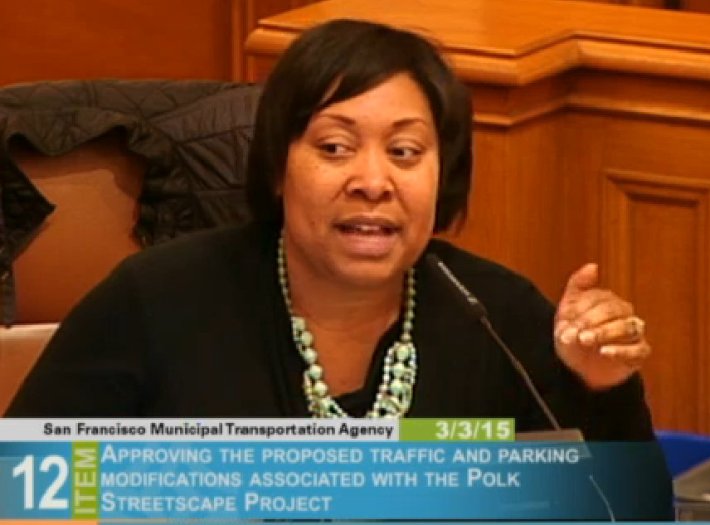
The SFMTA Board of Directors voted unanimously yesterday to approve the watered-down plan to redesign Polk Street with a protected bike lane along one side of the street for 10 of 20 blocks.
The board rebuffed efforts by member Cheryl Brinkman to preserve the possibility of adding protected bike lanes along the upper half of the corridor before the project is constructed. Instead, the board added the condition that SFMTA staff would report on the impacts of the redesign a year after it’s completed, when they will consider extending protected bike lanes in a follow-up project.
The decision came after a four-hour hearing, where hundreds of people spoke. Roughly half called for a bolder project that puts safety first, and the rest -- many of them merchants -- opposed the project in order to preserve car parking.
The board did not discuss the block of Polk between California and Pine Streets, where Mayor Ed Lee's optometrist successfully lobbied to remove bike lane protection from the project six months after it was presented to the public. When asked if he'd taken any action on the project, Mayor Lee told Streetsblog last week, "We shouldn’t promote bicycle safety over pedestrian safety over cars and parking. I think they’re all going to be important.”
Supervisors Jane Kim and Julie Christensen, whose districts share a border along Polk, weighed in at the hearing.
D6 Supervisor Kim took the stronger stand for a safer Polk, calling on the SFMTA to "prioritize people over cars and to model Vision Zero for the rest of the city."
"As someone who's a beginning cyclist... if you want more people like me driving less, I'm going to want to see protected bike lanes," said Kim. "That's just the reality." With heavy motor traffic and steeper grades on nearby streets, she said, "Polk Street is the only corridor that we can have a protected, green bike lane for the entire north-south" route. She also said she was "disappointed" about the removal of the bike lane on the block between California and Pine.
Christensen, who was recently appointed by Lee to fill David Chiu's District 3 seat, called on the board to approve the project as-is, so as not to delay the pedestrian safety improvements or undergound utility work, and "continue to debate the merits of changes further north."
Unlike Kim, she did not make the case that a safer design should be an urgent priority. "We have thousands of people storing their cars on the street," said Christensen. "While we want to discourage them from doing that, that is not going to change overnight."
Under the approved plan, 92 percent of on-street parking spaces within a block of Polk will remain, as will 70 percent of parking on Polk [PDF]. In total, there are more than 5,000 parking spaces within a block of Polk (on- and off-street), of which Polk's existing 320 spaces account for just 6 percent [PDF].
Eighty-five percent of people on Polk arrive without a car. And as Brinkman has pointed out, those who do drive to Polk rarely find a parking spot in front of their destination, since Polk's parking meters don't have SFPark.
None of that seemed to sink in with SFMTA Board member Gwyneth Borden, who argued for the "compromise" on Polk by citing the 1986 General Plan's first priority: "That existing neighborhood-serving retail uses be preserved and enhanced." According to Borden's interpretation, that means keeping curbs lined with car parking, not bike lanes.
"I'm not saying other things aren't important, because clearly they are -- safety is paramount," she said. "But we forget cannot what makes San Francisco San Francisco -- our neighborhoods." (So apparently what makes our neighborhoods our neighborhoods is curbside parking on every block.)
"I don't think what we're proposing is favoring the car," added Borden, who went on to say that "there's a sense of self-righteousness" among many people who bike and don't drive. Meanwhile, opponents of the redesign said that removing parking spaces for bike lanes would be an affront to business, the elderly, community, and families.
As for those self-righteous people on bikes, Kelly Eastman, a Polk neighbor who said she bikes to businesses along the street, told the SFMTA Board that by approving full protected bike lanes, "You might be saving my life, or the life of someone here today. Please take that chance."
SF Bicycle Coalition Executive Director Noah Budnick said that as the SFMTA measures the impacts of "the improvements that were approved today," they will be "the foundation to build on."
"The MTA’s data-driven approach, I predict, is going to show that safety improves, traffic is reduced, businesses thrive, and will back up the case for extending pedestrian and bicycle safety improvements for the entire length of the street,” said Budnick.
SFMTA Board member Joel Ramos told Streetsblog he thinks the clout of merchants on Polk led to a more "incremental, comfortable" approach than the city's stated commitments to Vision Zero and increased bicycling would call for. The improvements "are a lot," he said, and "ultimately, we'll be able to learn whether it was enough or not."







